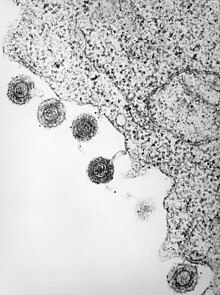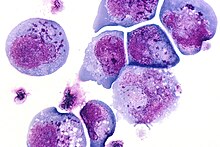Human herpes virus 6
| Human herpes virus 6A and 6B | ||||||||||||||||||||
|---|---|---|---|---|---|---|---|---|---|---|---|---|---|---|---|---|---|---|---|---|

HHV-6 virus particles under the electron microscope . |
||||||||||||||||||||
| Systematics | ||||||||||||||||||||
|
||||||||||||||||||||
| Scientific name | ||||||||||||||||||||
| Human beta herpesvirus 6A , 6B | ||||||||||||||||||||
| Short name | ||||||||||||||||||||
| HHV-6A, HHV-6B | ||||||||||||||||||||
| Left | ||||||||||||||||||||
|
The human herpes virus types 6A and 6B ( HHV-6A and 6B ) are two human pathogenic species of the virus genus Herpesvirus from the subfamily of beta herpes viruses . The International Committee on Taxonomy of Viruses (ICTV) divided the earlier virus species ( human ) herpesvirus 6 as of March 2019 and raised the two subtypes A and B to the rank of species.
HHV-6B is the cause of three-day fever ( Exanthema subitum alias Roseola infantum , "Sixth Disease" ), a disease that occurs mainly in infancy or early childhood . No diseases have been associated with the species HHV-6A (the former HHV-6 subtype A). The involvement of these viruses in other diseases is discussed.
Historical
HHV-6A was discovered in 1986 in Robert Gallo's group at the NIH . The explorers believed it with a B cell - lymphotropic to have to do herpesvirus (hence the outdated acronym HBLV). It soon turned out, however, that HHV-6 infected CD4- positive T lymphocytes . HHV-6 is the only human herpesvirus known to date that primarily infects T-lymphocytes (all other human herpesviruses are B-cell lymphotropic) alongside the human herpesvirus type 7, which was discovered later .
Epidemiology and transmission


HHV-6A / B are practically ubiquitous viruses. In adulthood, at least 80% of the population are seropositive, that is, they are latently infected with one of the viruses (although not necessarily sick). The infection usually occurs in infancy or toddler age through droplet infection and is often clinically inapparent, i.e. without any significant symptoms. The symptomatic infection usually manifests itself as a three-day fever .
latency
Like all herpes viruses, HHV-6A and 6B have the ability to "latency", that is, to "persist" in the organism for a long time. As a rule, the virus can no longer be completely eliminated after infection. However, most of the time it doesn't cause any further problems, but it can revive and reproduce again if the immune system is weakened.
HHV-6 encephalitis
In immunocompromised patients, particularly after allogeneic stem cell transplantation , the HHV-6B one of the most common causes is an encephalitis . This leads to a reactivation of a chronic latent HHV-6B infection, which can be detected in 30–70% of stem cell transplant recipients. The incidence of HHV-6 encephalitis after stem cell transplantation is 1.4%, but 98% of all encephalitides after stem cell transplantation are due to HHV-6B. An HLA mismatch, T cell depletion and cortisone therapy are considered risk factors for reactivation . Furthermore, 90% of all patients with HHV-6 encephalitis received cord blood stem cells .
Encephalitis is rarely fulminant, but mostly subacute , begins slowly and often manifests itself initially as confusion , plus anterograde amnesia , personality changes , irritability and epileptic seizures . Fever is rare. In the CSF there is often a slight leukocytosis , mainly as lymphocytosis and with increased protein levels. A virus detection is possible in the CSF. In the MRI also find mostly no specific changes, but rarely lesions can be found in the amygdala or the hippocampus.
The first symptoms can appear two to six weeks after the stem cell transplant, but latencies up to twenty weeks after the transplant have also been observed.
The antiviral treatment is empirical, there are only observational studies before. The first choice is Foscarnet , alternatively or additionally ganciclovir can be used, while cidofovir is rather avoided because of the high risk of kidney damage. Since these two agents are also associated with serious adverse effects, u. a. Kidney damage, bone marrow suppression , electrolyte changes, and epileptic seizures must be closely monitored.
Virus detection
Virus detection is usually carried out serologically , that is, by detecting antibodies against the virus. However, these are only formed some time after infection. In babies, there may also be antibodies that have been transmitted through the placenta by the mother and that can distort the picture. In the acute infection phase, the virus DNA can be detected using the polymerase chain reaction (PCR) or electron microscopy. In addition to the detection in the peripheral blood, this is possible in people with an inherited chromosomal integrated HHV6 infection in every body cell.
Therapy and vaccination
A vaccination against HHV-6B is not yet available. In the event of serious complications (e.g. encephalitis), antiviral therapy with ganciclovir or foscarnet should be attempted. So far, however, there are no larger studies that would prove the effectiveness of these antivirals .
HHV-6A and 6B as a trigger for other diseases
The viruses can cause myocarditis or cardiomyopathy. They are also being discussed as possible factors in the development of multiple sclerosis and Alzheimer's disease . However, there are no clear data that would prove involvement in these diseases. There is a study that suggests a link between infection with HHV-6A and infertility .
literature
- Siegfried Wiersbitzky, Roswitha Bruns, Heidrun Wiersbitzky: Infections with the herpes virus 6 - really just "Exanthema subitum"? Part I: More common clinical pictures. In: Advances in Medicine. Volume 110, No. 32 (pp. 41-59), 1992, pp. 599-603.
- DM Zerr: Human herpesvirus 6: a clinical update. In: Herpes: the journal of the IHMF. Volume 13, No. 1, May 2006, pp. 20-24, ISSN 0969-7667 . PMID 16732999 . (Review).
- L. De Bolle, L. Naesens, E. De Clercq: Update on human herpesvirus 6 biology, clinical features, and therapy. In: Clinical microbiology reviews. Volume 18, Number 1, January 2005, pp. 217-245, ISSN 0893-8512 . doi: 10.1128 / CMR.18.1.217-245.2005 . PMID 15653828 . PMC 544175 (free full text). (Review).
- CB Hall, MT Caserta et al .: Chromosomal integration of human herpesvirus 6 is the major mode of congenital human herpesvirus 6 infection. In: Pediatrics. Volume 122, only. 3, September 2008, pp. 513-520, ISSN 1098-4275 . doi: 10.1542 / peds.2007-2838 . PMID 18762520 .
- G. Morissette, L. Flamand: Herpesviruses and chromosomal integration. In: Journal of virology. Volume 84, No. 23, December 2010, pp. 12100-12109, ISSN 1098-5514 . doi: 10.1128 / JVI.01169-10 . PMID 20844040 . PMC 2976420 (free full text). (Review).
Individual evidence
- ↑ a b c d e ICTV: ICTV Taxonomy history: Human alphaherpesvirus 1 , EC 51, Berlin, Germany, July 2019; Email ratification March 2020 (MSL # 35)
- ↑ ICTV : Master Species List 2018b.v2 , MSL # 34, March 2019
- ^ SZ Salahuddin: Isolation of a new virus, HBLV, in patients with lymphoproliferative disorders. In: Science. 234 (4776), 1986, pp. 596-601. PMID 2876520
- ↑ Areej R. El-Jawahri, Pamela W. Schaefer, Joseph B. El Khoury, Maria Martinez-Lage: Case 5-2018: A 63-Year-Old Man with Confusion after Stem-Cell Transplantation . New England Journal of Medicine 2018, Volume 378, Issue 7 February 15, 2018, pp. 659-669, DOI: 10.1056 / NEJMcpc1707556
- ↑ S. Pankuweit, B. Maisch: The heart in viral infections. In: The internist. June 2010, doi: 10.1007 / s00108-009-2559-8
- ↑ Ben Readhead, Jean-Vianney Haure-Mirande, Cory C. Funk, Matthew A. Richards, Paul Shannon: Multiscale Analysis of Independent Alzheimer's Cohorts Finds Disruption of Molecular, Genetic, and Clinical Networks by Human Herpesvirus . In: Neuron . tape 0 , no. June 0 , 2018, ISSN 0896-6273 , doi : 10.1016 / j.neuron.2018.05.023 ( cell.com [accessed June 23, 2018]).
- ^ R. Marci, V. Gentili, D. Bortolotti, G. Lo Monte, E. Caselli, S. Bolzani and others. a .: Presence of HHV-6A in Endometrial Epithelial Cells from Women with Primary Unexplained Infertility. In: PLoS ONE. 11 (7), 2016, p. E0158304. doi: 10.1371 / journal.pone.0158304